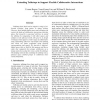54 search results - page 7 / 11 » Designing games to motivate physical activity |
89
Voted
TABLETOP
2006
IEEE
15 years 5 months ago
2006
IEEE
Tabletops have been used to support a range of colocated activities, from games to image sorting. However, their limited display space and resolution can restrict the kinds of col...
111
Voted
DAIS
2009
15 years 23 days ago
2009
Ubiquitous computing architectures enable interaction and collaboration in multi-user applications. We explore the challenges of integrating the disparate services required in such...
109
Voted
ISER
1999
Springer
15 years 3 months ago
1999
Springer
: We are developing a robotic measurement facility which makes it very easy to build “reality-based” models, i.e., computational models of existing, physical objects based on a...
89
Voted
TABLETOP
2008
IEEE
15 years 6 months ago
2008
IEEE
To date, digital tabletop research has predominantly focused on resolving fundamental software and hardware challenges introduced by this new interactive platform. Understanding n...
82
Voted
AAAI
1998
15 years 1 months ago
1998
This paper describes design criteria for creating highly embedded, interactive spaces that we call Intelligent Environments. The motivation for building these systems is to bring ...

